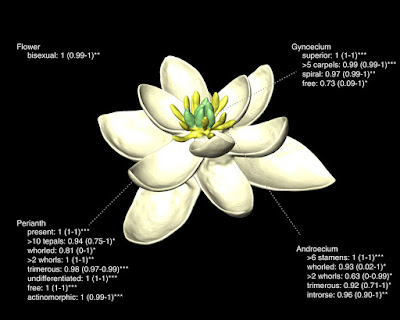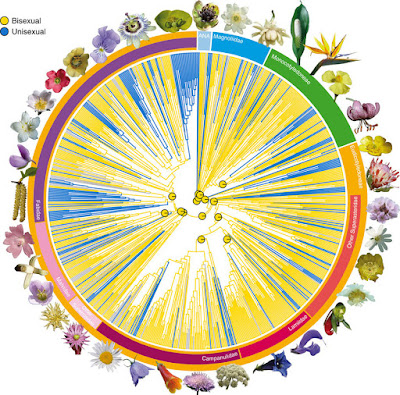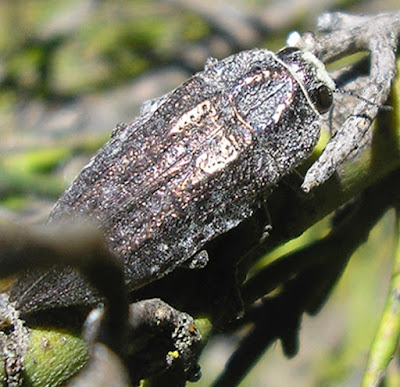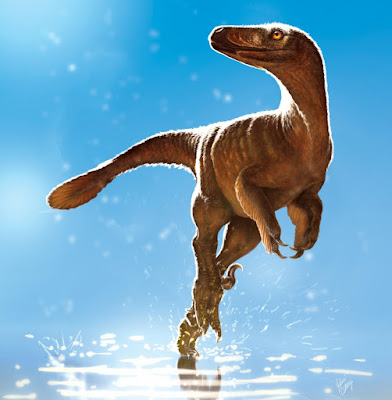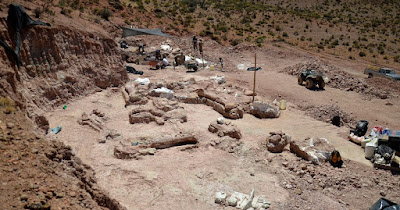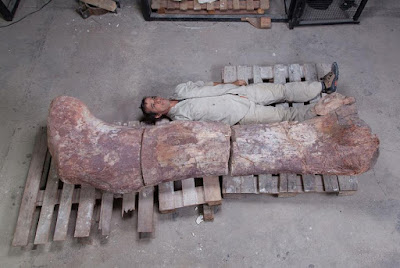[Most Recent Entries] [Calendar View]
Wednesday, August 9th, 2017
| Time | Event | ||||
| 1:07a | [PaleoBotany • 2017] The Ancestral Flower of Angiosperms and Its Early Diversification Abstract Recent advances in molecular phylogenetics and a series of important palaeobotanical discoveries have revolutionized our understanding of angiosperm diversification. Yet, the origin and early evolution of their most characteristic feature, the flower, remains poorly understood. In particular, the structure of the ancestral flower of all living angiosperms is still uncertain. Here we report model-based reconstructions for ancestral flowers at the deepest nodes in the phylogeny of angiosperms, using the largest data set of floral traits ever assembled. We reconstruct the ancestral angiosperm flower as bisexual and radially symmetric, with more than two whorls of three separate perianth organs each (undifferentiated tepals), more than two whorls of three separate stamens each, and more than five spirally arranged separate carpels. Although uncertainty remains for some of the characters, our reconstruction allows us to propose a new plausible scenario for the early diversification of flowers, leading to new testable hypotheses for future research on angiosperms. Hervé Sauquet, Maria von Balthazar, Susana Magallón, James A. Doyle, Peter K. Endress, Emily J. Bailes, Erica Barroso de Morais, Kester Bull-Hereñu, Laetitia Carrive, Marion Chartier, Guillaume Chomicki, Mario Coiro, Raphaël Cornette, Juliana H. L. El Ottra, Cyril Epicoco, Charles S. P. Foster, Florian Jabbour, Agathe Haevermans, Thomas Haevermans, Rebeca Hernández, Stefan A. Little, Stefan Löfstrand, Javier A. Luna, Julien Massoni, Sophie Nadot, Susanne Pamperl, Charlotte Prieu, Elisabeth Reyes, Patrícia dos Santos, Kristel M. Schoonderwoerd, Susanne Sontag, Anaëlle Soulebeau, Yannick Staedler, Georg F. Tschan, Amy Wing-Sze Leung and Jürg Schönenberger. 2017. The Ancestral Flower of Angiosperms and Its Early Diversification. Nature Communications. 8, Article number: 16047. DOI: 10.1038/ncomms16047 Revealed: the first ever flower, 140m years ago, looked like a magnolia theconversation.com/revealed-the-first-e | ||||
| 4:20a | [Entomology • 2017] Ectinogonia cryptica • Genetic and Morphological Evidence for A New Cryptic Species of Ectinogonia (Coleoptera: Buprestidae) from central Chile
Abstract The genus Ectinogonia Spinola, 1837 is a genus mainly found in Chile; it currently contains 17 species. Recent exploration in the Andes Mountain Range of the Bio Bio Region in Chile have resulted in the collection of specimens slightly different morphologically from all previously described species. The aim of this paper is to describe this new species of Ectinogonia using morphological and genetic evidence. To establish differences between species we described the external morphology and compared it to species that are morphologically similar (i.e. E. buqueti Spinola 1837 and E. intermedia Kerremans 1903). We also measured the genetic differences in COI sequences, constructing a distance matrix in which we compared it to species that are morphologically similar (E. buqueti and E. intermedia) and other species found in the same region (E. speciosa oscuripennis Moore 1994). We found that Ectinogonia cryptica sp. n. differs from E. buqueti (which previously contained E. cryptica sp. n.) in pronotum and elytral patterns. The genetic distance matrix shows that E. cryptica sp. n. differs by 4.6% from all other Ectinogonia species compared, supporting the morphological evidence. Keywords: Coleoptera, Chrysochroinae, Dicercini, Ectinogonia cryptica sp. n., genetic distance, taxonomy Simón Anguita-Salinas, Rodrigo M. Barahona-Rodrigo, Elie Poulin and Alvaro Zúñiga-Reinoso. 2017. Genetic and Morphological Evidence for A New Cryptic Species of Ectinogonia (Coleoptera: Buprestidae) from central Chile. Zootaxa. 4303(2); 284–292. DOI: 10.11646/zootaxa.4303.2.8 | ||||
| 6:45a | [Paleontology • 2017] Troodontids (Theropoda) from the Dinosaur Park Formation, Alberta, with A Description of A Unique New Taxon, Latenivenatrix mcmasterae: Implications for Deinonychosaur Diversity in North America
ABSTRACT Troodontids are known from Asia and North America, with the most complete specimens from the Jurassic of China and the Cretaceous of Mongolia. North American troodontids are poorly known, and specimens that have been described are isolated elements or partial skeletons with limited material. A new troodontid from the upper Dinosaur Park Formation (upper Campanian) is based on partial skulls, several vertebrae, ribs, gastralia, chevrons, a sacrum, partial pelvis, and partial fore and hind limbs. It is the largest troodontid known, with an estimated height of 180 cm and length of 350 cm. Like other troodontids, it possesses an elongated ambiens process and has a horizontal ventral margin of the postacetabular process. It differs from all other derived troodontids in that the slightly retroverted pubis has a shaft that curves anteroventrally. Some specimens from the Dinosaur Park Formation previously assigned to Troodon are reassigned to the new taxon, including multiple partial crania, an associated dentary and metatarsus, and a partial skeleton. Previously undescribed elements from the lower part of the Dinosaur Park Formation are assigned to the resurrected Stenonychosaurus inequalis. Distinct stratigraphic separation of Stenonychosaurus inequalis and the new taxon indicates a replacement in troodontid fauna, similar to the turnover of large ornithischians in the same formation. The new taxon is phylogenetically more closely related to Mongolian taxa, indicating the replacement of Stenonychosaurus may have been from an earlier Asian form immigrating into North America.
Systematic palaeontology Theropoda Marsh, 1881 Maniraptora Gauthier, 1986 Troodontidae Gilmore, 1924 sensu Turner et al. 2012 Troodontinae, clade nov. DEFINITION: The most inclusive clade containing Gobivenator mongoliensis and Zanabazar junior. DIAGNOSIS: Troodontinae differs from all other more basal troodontids by possessing an elongated ambiens process that is present on the anterior margin of the iliopubic symphysis. Latenivenatrix gen. nov. Latenivenatrix mcmasterae gen. et sp. nov. ETYMOLOGY: The generic name derives from “latens” (Latin for latent and hiding) and “venatrix” (feminine form in Latin for hunter). “Latent” refers to the taxon having been in multiple collections for nearly 100 years but unrecognized until now. “Hiding” has a similar meaning to latent, but also refers to a predatory animal hiding in cover until a suitable time to attack its prey. “Hunter” refers to it being carnivorous. The specific epithet honours the late mother of the first author, Lynne (McMaster) van der Reest. Stenonychosaurus inequalis Sternberg, 1932 Aaron J. van der Reest and Philip J. Currie. 2017. Troodontids (Theropoda) from the Dinosaur Park Formation, Alberta, with A Description of A Unique New Taxon: Implications for Deinonychosaur Diversity in North America. Canadian Journal of Earth Sciences. 54; xx. DOI: 10.1139/cjes-2017-0031 Introducing Latenivenatrix mcmasterae, new Troodontid from the DPF published in @CanJEarthSci this morning! Sorry Troodon formosus #invalid Dino hips discovery unravels species riddle bit.ly/2ulK0w6 via @ualberta @EurekAlert Résumé: Les troodontidés connus proviennent d’Asie et d’Amérique du Nord, les spécimens les plus complets provenant du Jurassique de la Chine et du Crétacé de la Mongolie. Les troodontidés nord-américains sont peu connus et les spécimens décrits consistent en des éléments isolés ou des squelettes partiels représentés par une quantité limitée de matériau. Un nouveau troodontidé de la partie supérieure de la Formation de Dinosaur Park (Campanien supérieur) est basé sur des crânes partiels, plusieurs vertèbres, des côtes, une gastralia, des chevrons, un sacrum, un pelvis partiel et des membres antérieurs et postérieurs partiels. Il s’agit du plus grand troodontidé connu, dont la hauteur est estimée a` 180 cm et la longueur, a` 350 cm. À l’instar d’autres troodontidés, il présente un processus ambiens allongé et une marge ventrale horizontale du processus post-acétabulaire. Il se distingue de tous les autres troodontidés dérivés par son pubis légèrement rétroversé doté d’une diaphyse courbée antéroventralement. Certains spécimens de la Formation de Dinosaur Park auparavant attribués a` Troodon, incluant plusieurs crânes partiels, un os dentaire et un métatarse associés, ainsi qu’un squelette partiel, sont réaffectés au nouveau taxon. Des éléments non décrits auparavant de la partie inférieure de la Formation de Dinosaur Park sont affectés a` Stenonychosaurus inequalis. La séparation stratigraphique claire de Stenonychosaurus inequalis et du nouveau taxon indique un remplacement de la faune de troodontidés semblable au renouvellement des grands ornithischiens de la même formation. Le nouveau taxon est plus étroitement apparenté sur le plan phylogénétique aux taxons de Mongolie, ce qui indique que le remplacement de Stenonychosaurus pourrait être dû a` l’immigration en Amérique du Nord d’une forme asiatique plus ancienne. | ||||
| 3:12p | [Paleontology • 2017] Patagotitan mayorum • A New Giant Titanosaur Sheds Light on Body Mass Evolution Among Sauropod Dinosaurs
Abstract Titanosauria was the most diverse and successful lineage of sauropod dinosaurs. This clade had its major radiation during the middle Early Cretaceous and survived up to the end of that period. Among sauropods, this lineage has the most disparate values of body mass, including the smallest and largest sauropods known. Although recent findings have improved our knowledge on giant titanosaur anatomy, there are still many unknown aspects about their evolution, especially for the most gigantic forms and the evolution of body mass in this clade. Here we describe a new giant titanosaur, which represents the largest species described so far and one of the most complete titanosaurs. Its inclusion in an extended phylogenetic analysis and the optimization of body mass reveals the presence of an endemic clade of giant titanosaurs inhabited Patagonia between the Albian and the Santonian. This clade includes most of the giant species of titanosaurs and represents the major increase in body mass in the history of Titanosauria. KEYWORDS: Titanosauria, Cretaceous, patagonia, taphonomy, Gondwana Systematic palaeontology Dinosauria Owen, 1842 Sauropoda Marsh, 1878 Titanosauria Bonaparte and Coria, 1993 Eutitanosauria Sanz et al., 1999 Lognkosauria Calvo et al., 2007 Patagotitan mayorum n. gen. et sp. Etymology: Patago from Patagonia (southern South America) and titan (Greek divinity) symbolic of strength and large size. The species name honours the Mayo family for their hospitality during fieldwork at the ‘La Flecha’ ranch. José L. Carballido, Diego Pol, Alejandro Otero, Ignacio A. Cerda, Leonardo Salgado, Alberto C. Garrido, Jahandar Ramezani, Néstor R. Cúneo and Javier M. Krause. 2017. A New Giant Titanosaur Sheds Light on Body Mass Evolution Among Sauropod Dinosaurs. Proceedings of the Royal Society B: Biological Sciences. 284(1860); 20171219. DOI: 10.1098/rspb.2017.1219 Patagotitan mayorum: New study describes the biggest dinosaur ever phy.so/421462792 via @physorg_com |
| << Previous Day |
2017/08/09 [Calendar] |
Next Day >> |

